The best businesses meet customer needs. But if you’re a new retailer or expanding an existing product line, the question is: How do you know what your buyers want?
Research and data are vital to discovering products with high sales potential, which is where Google Trends comes in. Google Trends can be critical to finding those products, with the platform able to provide insights and analysis on Google’s top search queries.
This guide shares how to use Google Trends to find trending products, with advice on how to make sense of the data you uncover.
Table of Contents
What is Google Trends?
Google Trendsuses Google data to show search insights for a particular word or term. This is relative to total searches made across the world in various languages.
从比较趋势随着时间的评价如何different regions behave, this tool can give you the information you need to build a business based on what people are looking for.
Google Trends is a great tool that allows retailers to identify and evaluate potential product ideas and measure the success of their business.
How can Google Trends help you find trending products?
Google is the most popular search engine in the world, receiving more thantwo trillion search queriesper year. Its complex algorithm uncovers the information you—and your customers—need.
Take it from Alexis Jae, founder ofAlexis Jae Jewelry, who uses Google Trends to analyze search volume when deciding which pieces to add to her brand’s jewelry line. “For example, our latest product is our paperclip bracelet with charm,” she says. “We knew we wanted to add a paperclip bracelet and used Google search volume and competition metrics to decide what type of paperclip bracelet to add.
“‘Paperclip bracelet with charm’ had high search volume and relatively low competition compared to other terms we looked at, such as ‘chunky paperclip bracelet’ and ‘adjustable paperclip bracelet.’”Bear in mind that there isn’t always a direct correlation between search volume and the popularity of a product. Other factors go into selling a product successfully, such as brand reputation, marketing, and market share of competitors. Trend-related data is simply a good place to start.
Get started with Shopify POS
Only Shopify gives you all the tools you need to manage your business, market to customers, and sell everywhere in one place. Unify in-store and online sales today.
Google Trends products: what to sell in 2023
Using Google Trends forproduct research? Here are some of the trending products you can sell this year.
Laser hair removal products
The number of people searching for “laser hair removal” on Google has remained stable over the past five years, making it a safe product category around which to build a long-term business.
Trending products to sell and capitalize on include:
- At-home laser hair removal machines
- 激光脱毛年代ervices
- Laser hair removal kits with aftercare products like exfoliators or moisturizer
Here, Google Trends shows the number of people searching for laser hair removal remains consistent:
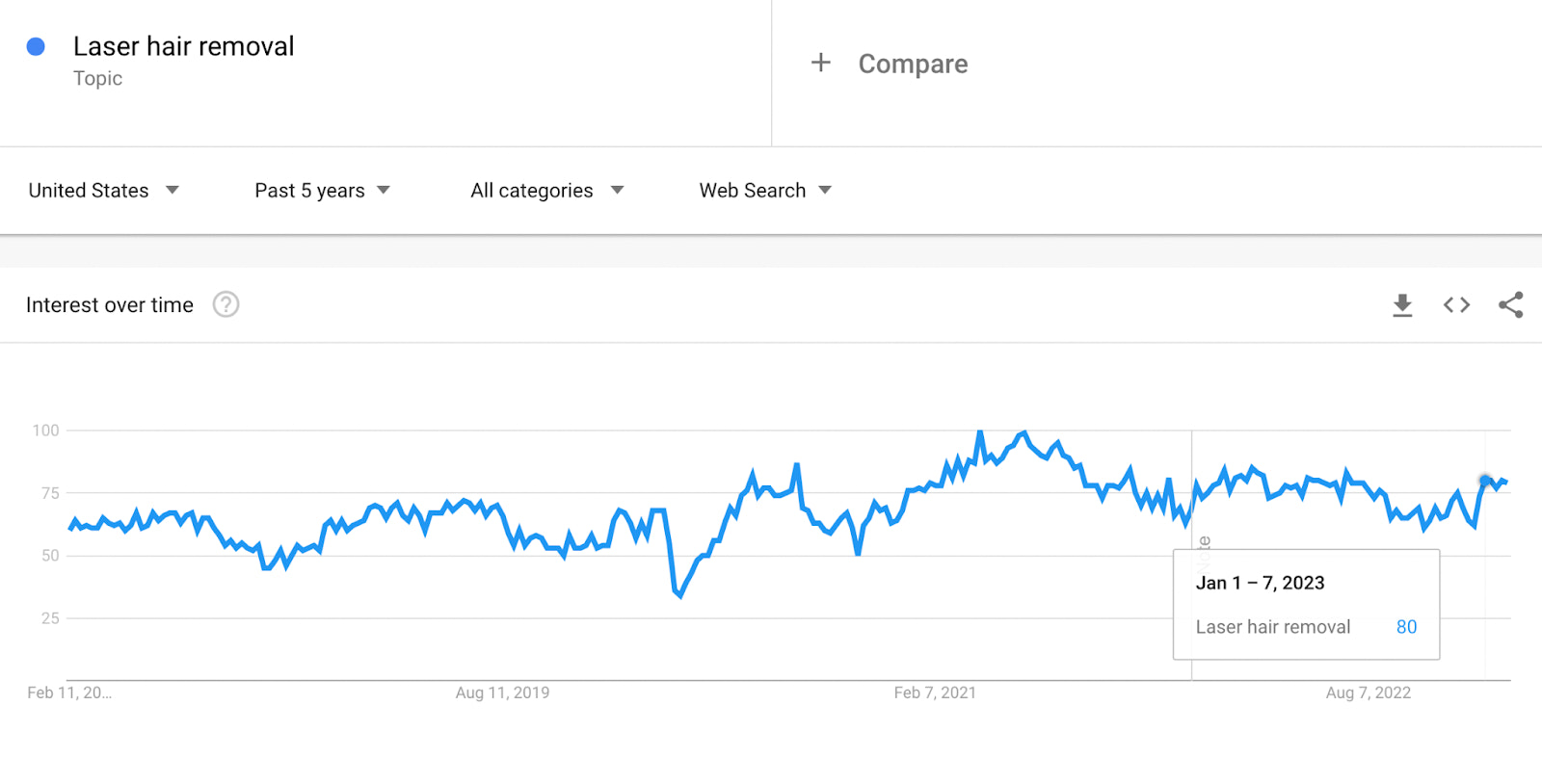
Head scarves
Head scarves have always been popular; Google Trends data from as far back as 2004 supports this.
Use Google Trends’ related queries section to find niche products within the broader head scarf industry. You could sell:
- Designer head scarves
- Handmade head scarves
- Head scarves for cancer patients
This screenshot shows Google Trends data for the keyword “head scarves”:

Detangling hair brushes
“Detangling hair brush” doesn’t have search volume, but that’s not to say people aren’t looking for the item. Tangle Teezer is one brand dominating this industry, with an average of 54 people searching the brand name each week.
Capitalize on this opportunity by:
- Building a brand around a hair detangling product
- UsingGoogle Adsto appear in the sponsored search results for “Tangle Teezer”
- Comparing your brushes’ features against the Tangle Teezer
As this chart shows, "Tangle Teezer" is searched for more than the generic "detangling hair brush":
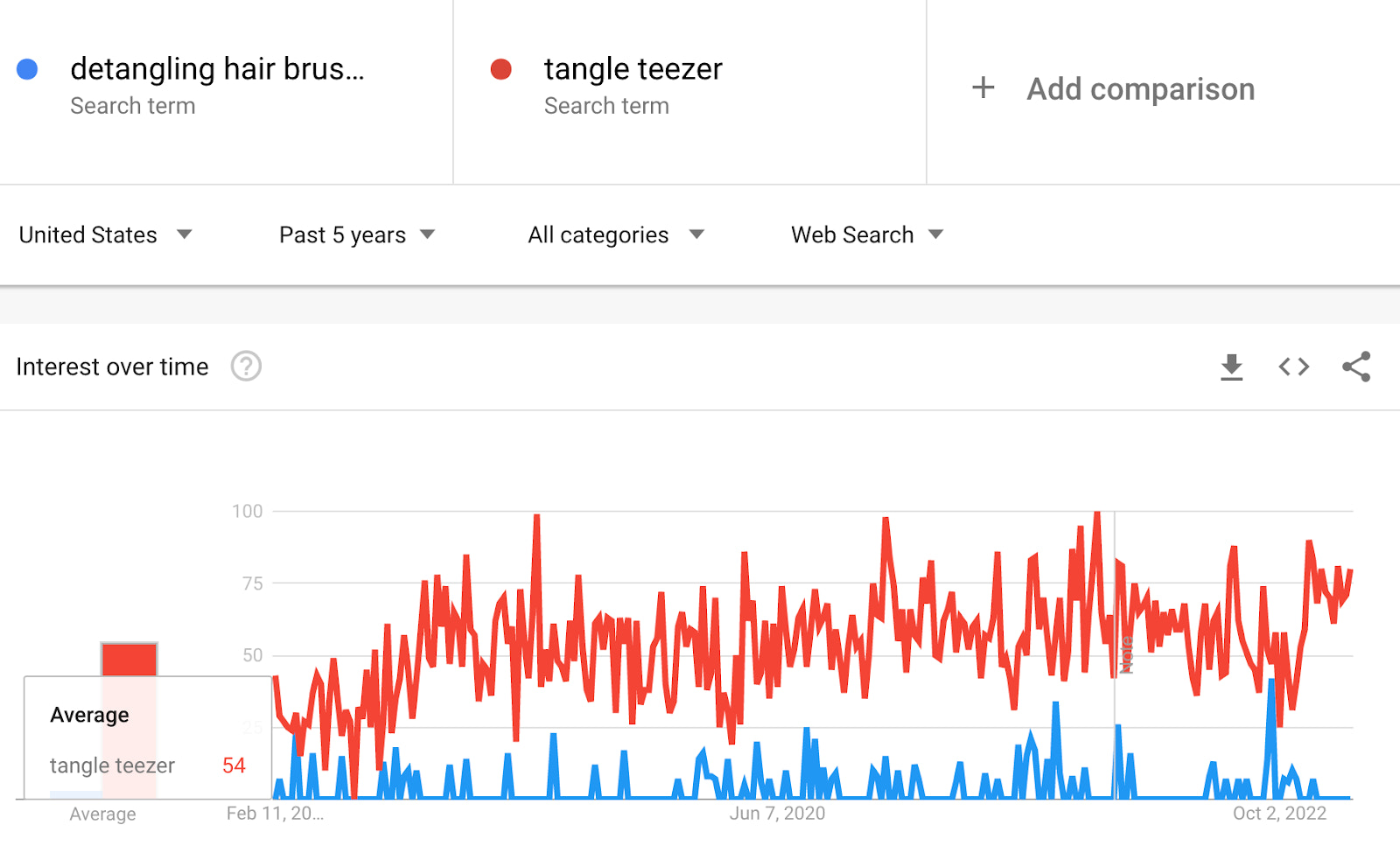
Athleisure
Athleisure is a relatively new concept that picked up momentum in 2016. The word is a combination of ”athletic” and “leisure” and describes a fashion concept in which people wear gym clothes for everyday use.
Capitalize on the athleisure trend by selling:
- Workout clothes
- Sneakers
- Sweatpants
This chart shows how the athleisure trend was born in 2016:
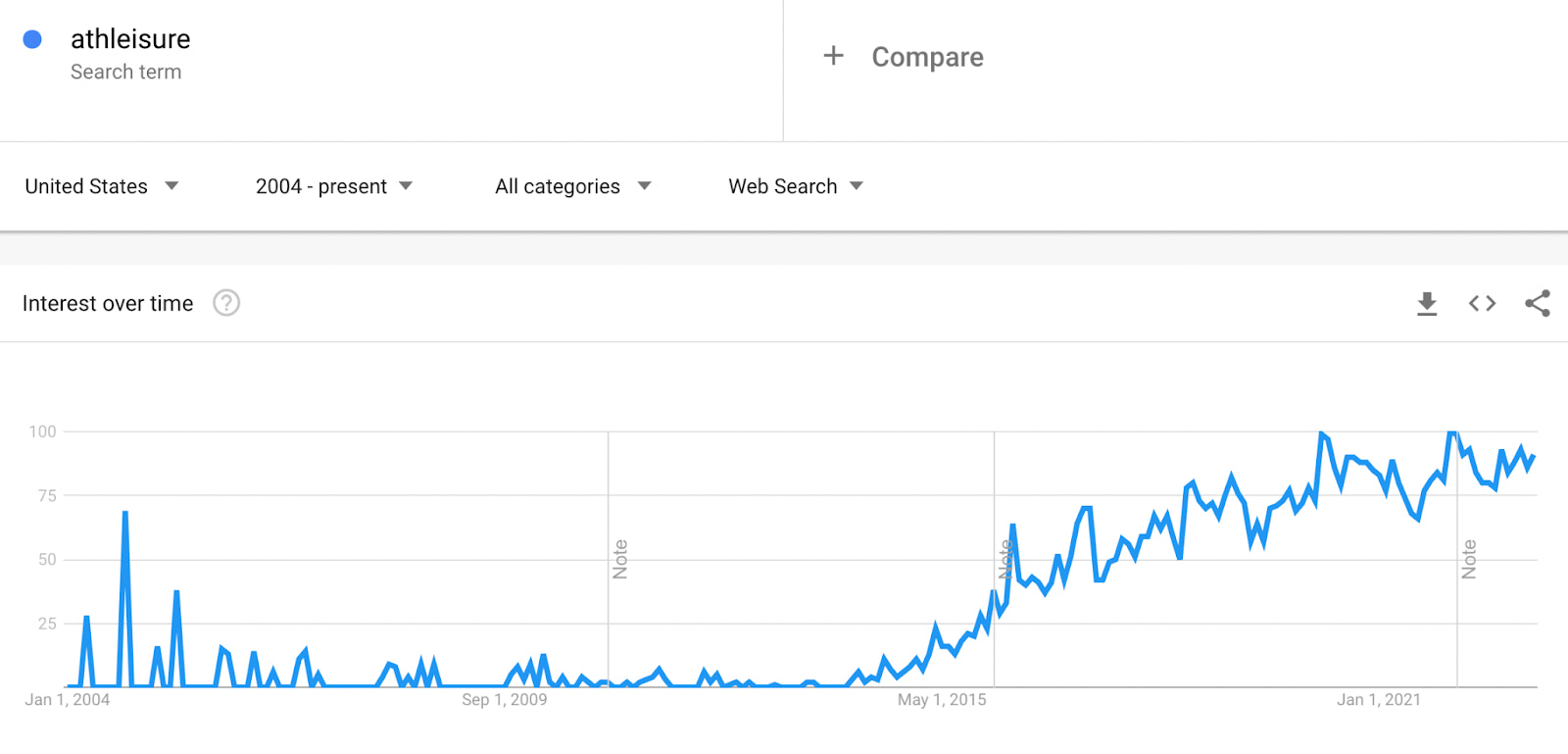
Reusable bags
An increasing number of customers are making theirshopping habits more sustainable. This might include not using single-use plastic, such as plastic shopping bags, in order to reduce their carbon footprint.
Niche products to sell in the recyclable bag industry include:
- 可重用的食物或购物袋
- Reusable bag gifts
- Foldable reusable bags
Google Trends data shows the number of people searching for “reusable bags” in the US was around 70 per week:
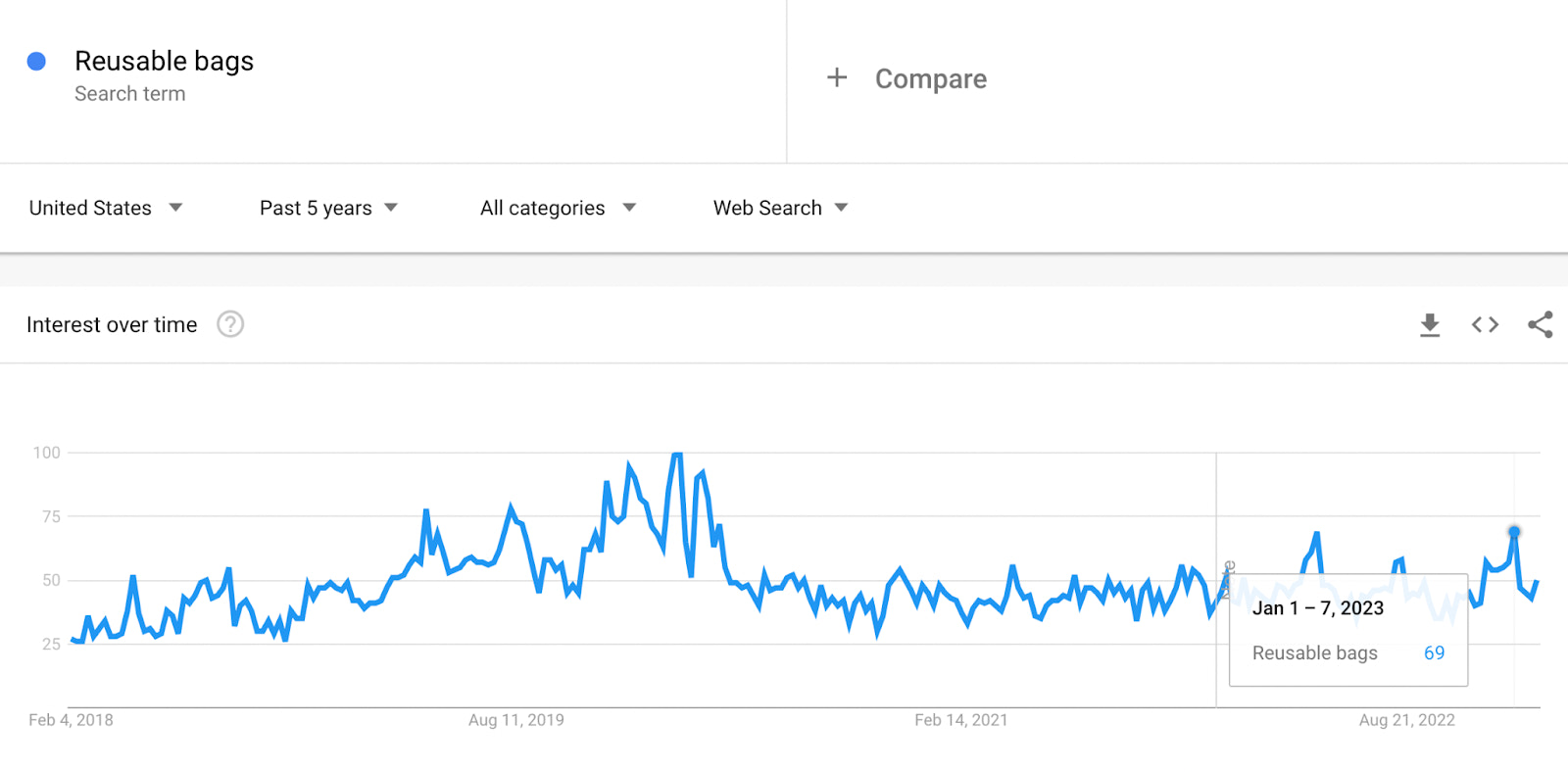
Air fryers
Air fryers are worth considering if you’re looking to sell high value products to a global market.
Google Trends shows the volume of people searching for air fryers has increased dramatically since 2020—likely due to the pandemic forcing people to cook more at home:
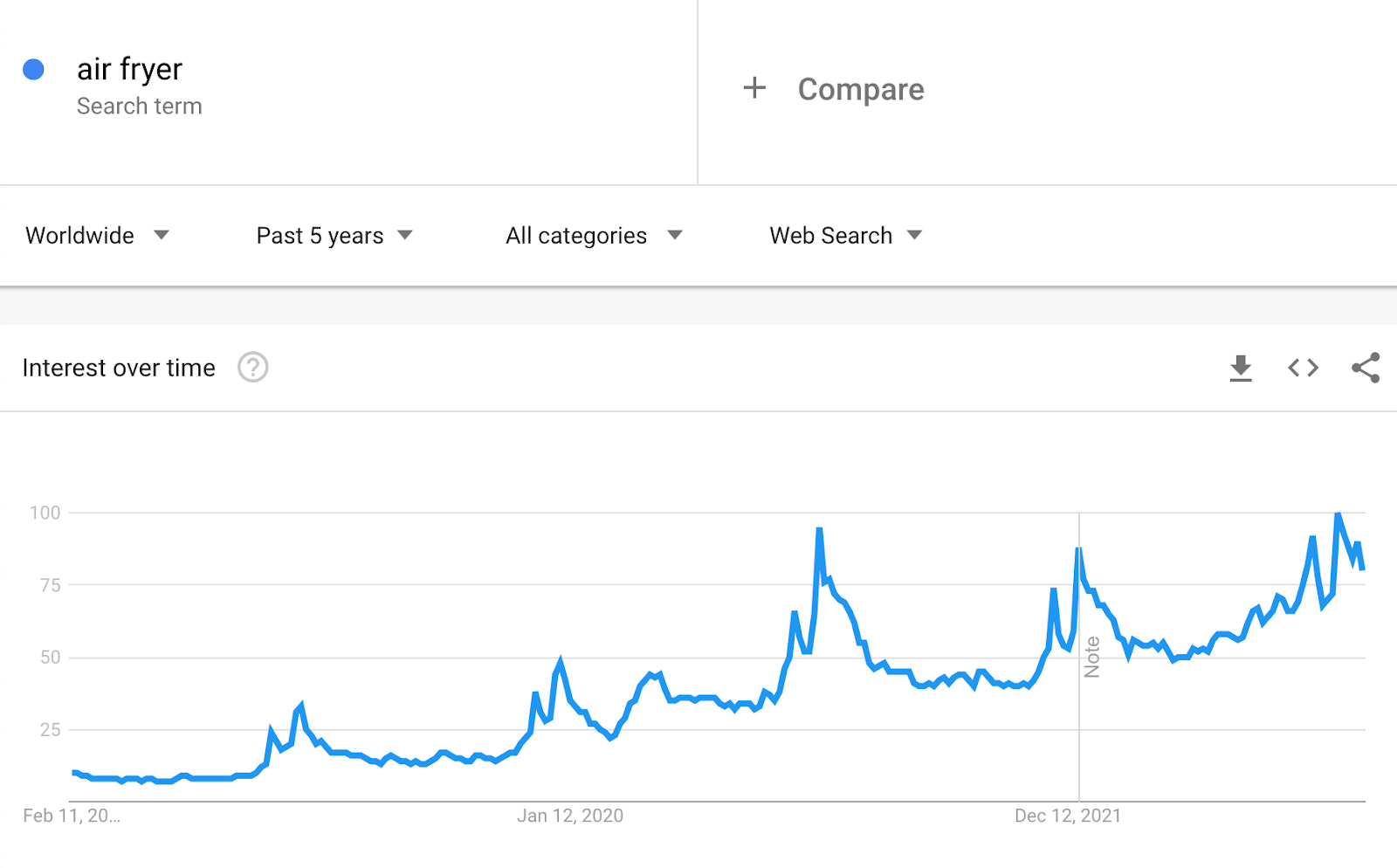
Teeth whitening products
The teeth whitening industry is predicted to beworth $8.21 billionby 2026. Google Trends data shows the following keywords are searched consistently, making them great items to sell in-store:
- Teeth whitening strips
- Teeth whitening kits
- Teeth whitening gels
- Teeth whitening lights
- Teeth whitening toothpaste
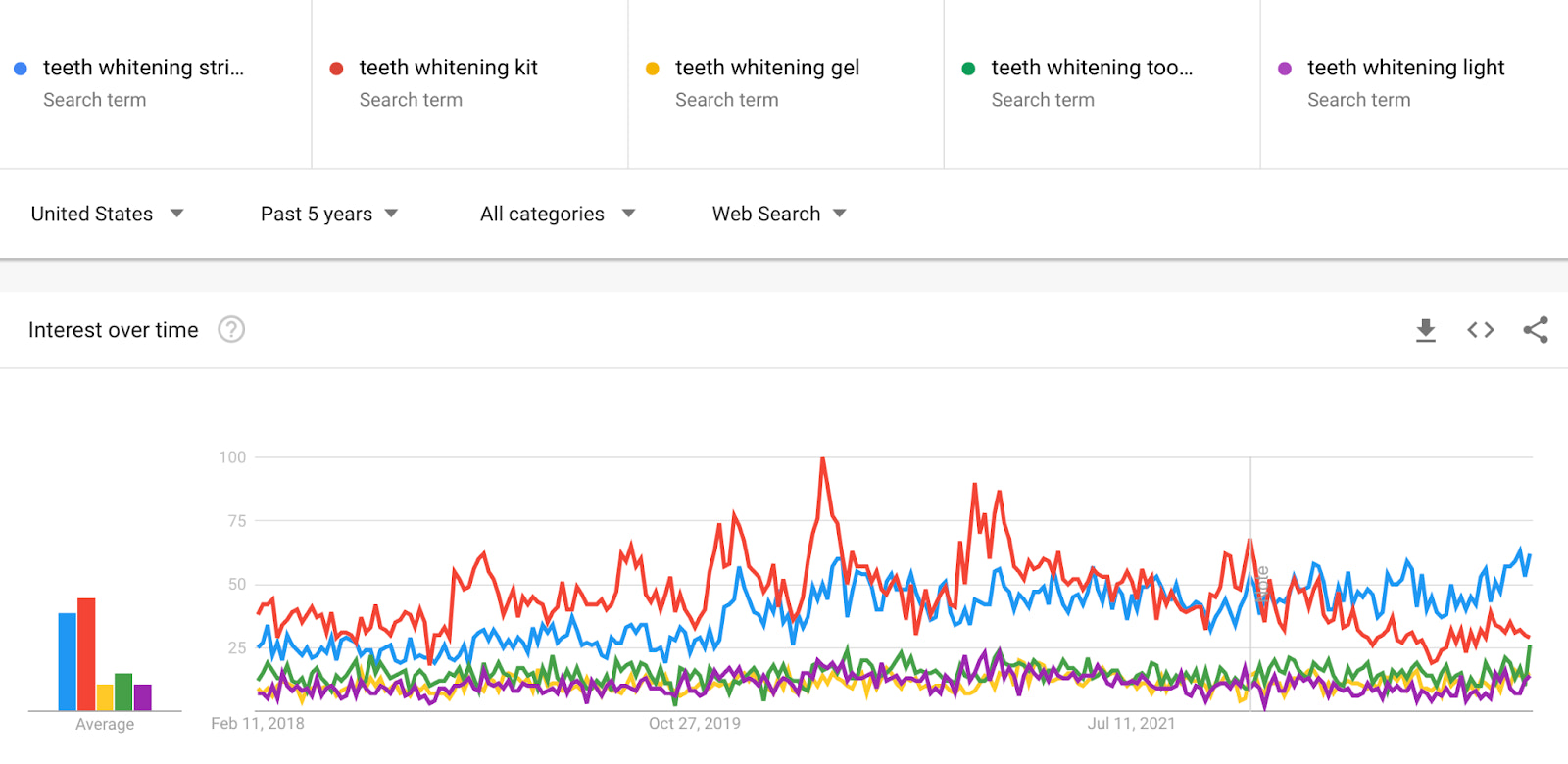
Anti-snoring products
Studies suggestthat 57% of men and 40% of women snore. It’s a frustration for many bed-sharers, as evidenced by Google Trends. Searches for anti-snoring products are consistent, including:
- Devices
- Pillows
- Mouthpieces
This Google Trends chart shows search volume for anti-snoring products:
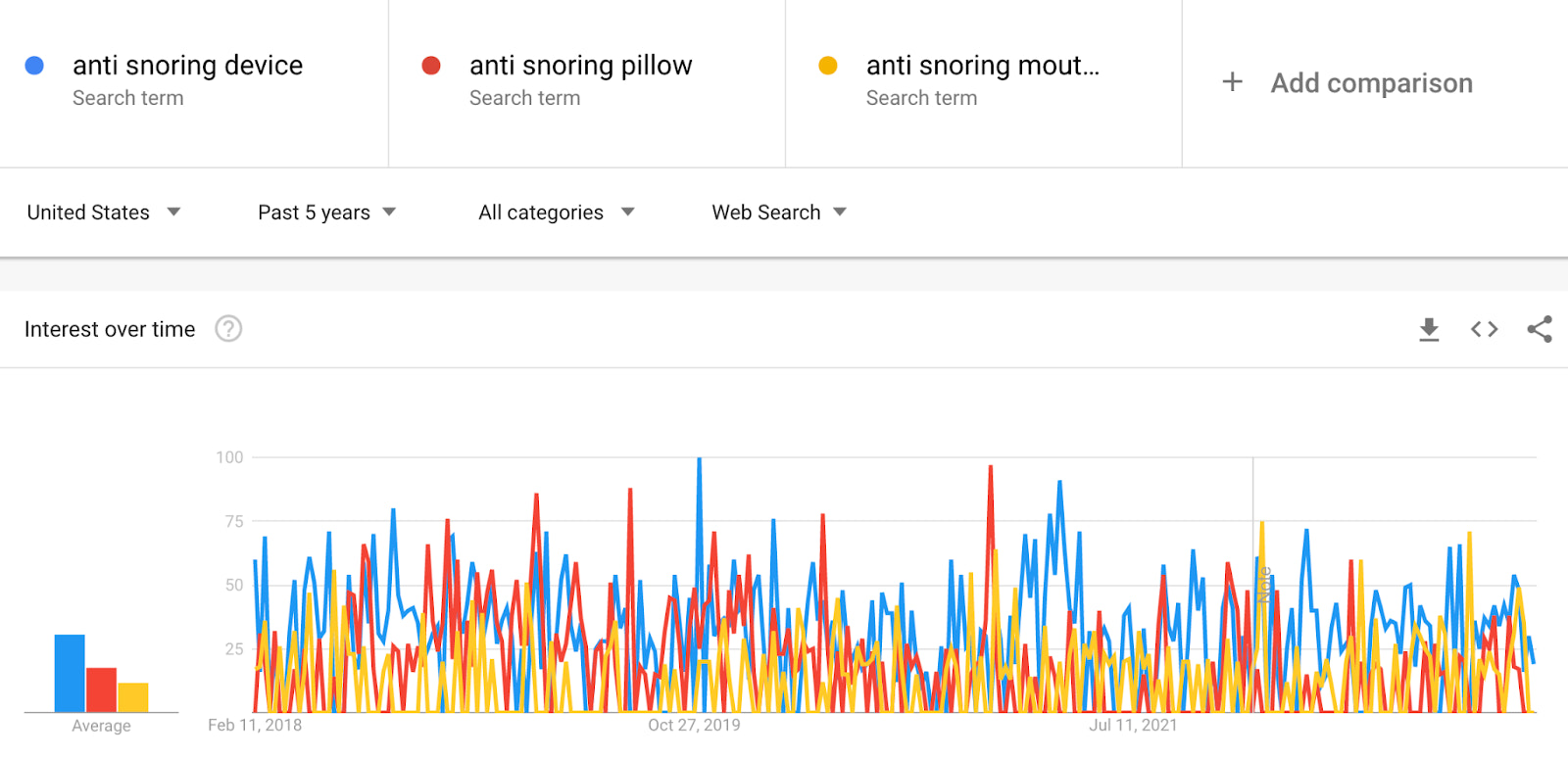
How to use Google Trends to find products
Head to the Google Trends homepage and type the keyword or phrase you want to find search data for. You’ll see a graph showing the search trend for that term, alongside localized data and related queries.
Now that you’re set up, here’s a comprehensive walkthrough of how to use Google Trends to find products you can sell in your retail store.
1. Use Google Trends data to find niches
Before you launch your retail business (or before you launch a new product, service, or branch of your brand), use Google Trends to validate your ideas.
If interest is low, demand might also be low. It could even indicate an uphill battle ahead inmaking the market awarethat your product even exists.
After seeing multiple media stories on the increase in accidental child exposure to cannabis products in recent years, and viewing Google Trends related to gummies and recreational dispensaries, I decided to develop a line of childproof storage boxes. Parents need a way to store cannabis products securely.
If you see a huge spike in interest at some point, followed by an equally steep decline and then a steady volume of search interest going forward, this might not be the bestsmall business idea. The jump in searches could suggest it was an unsustainable product.
2. Look for relevant product categories in related topics
Google Trends isn’t just a goldmine for identifying popular products. Retailers can use its data to expand product lines and categorize inventory.
Beauty retailers searching the Google Trends data for “moisturizer” see topics like CeraVe, Neutrogena, night, and sunscreen—four potential avenues to explore an already-popular product line. They could:
- Stock CeraVe or Neutrogena products
- Create avisual merchandising displayof nighttime skin care products
- Highlight a moisturizer’s SPF contents in product packaging
This screenshot shows how related topics are surfaced on Google Trends:
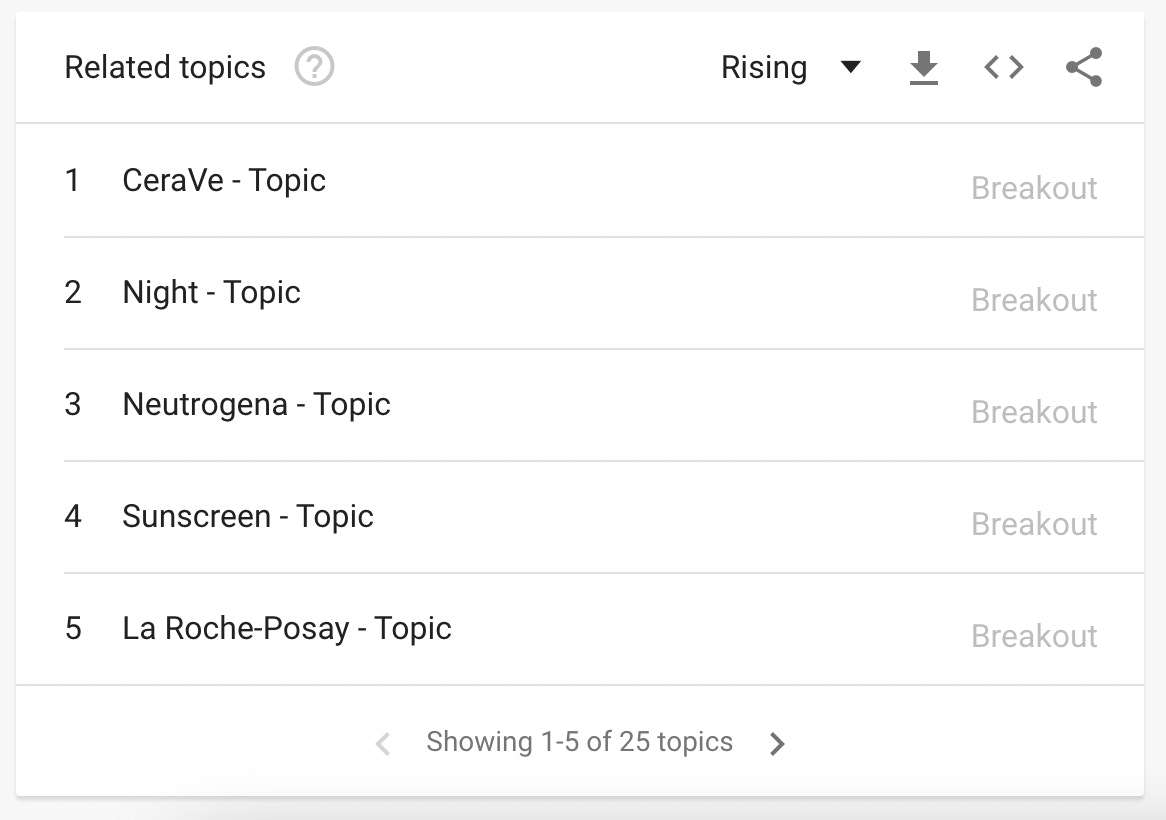
3. Identify seasonal trends to promote relevant products
Not all products are popular year-round. The most obvious examples are Christmas related; people generally don’t buy Santa-themed decorations in June. Demand peaks in the later months of the year.
Products that might not seem seasonal often have cyclical purchase patterns. Google Trends shows searches for “lunchbox,” for example, peak in August—just before the start of a new school year:
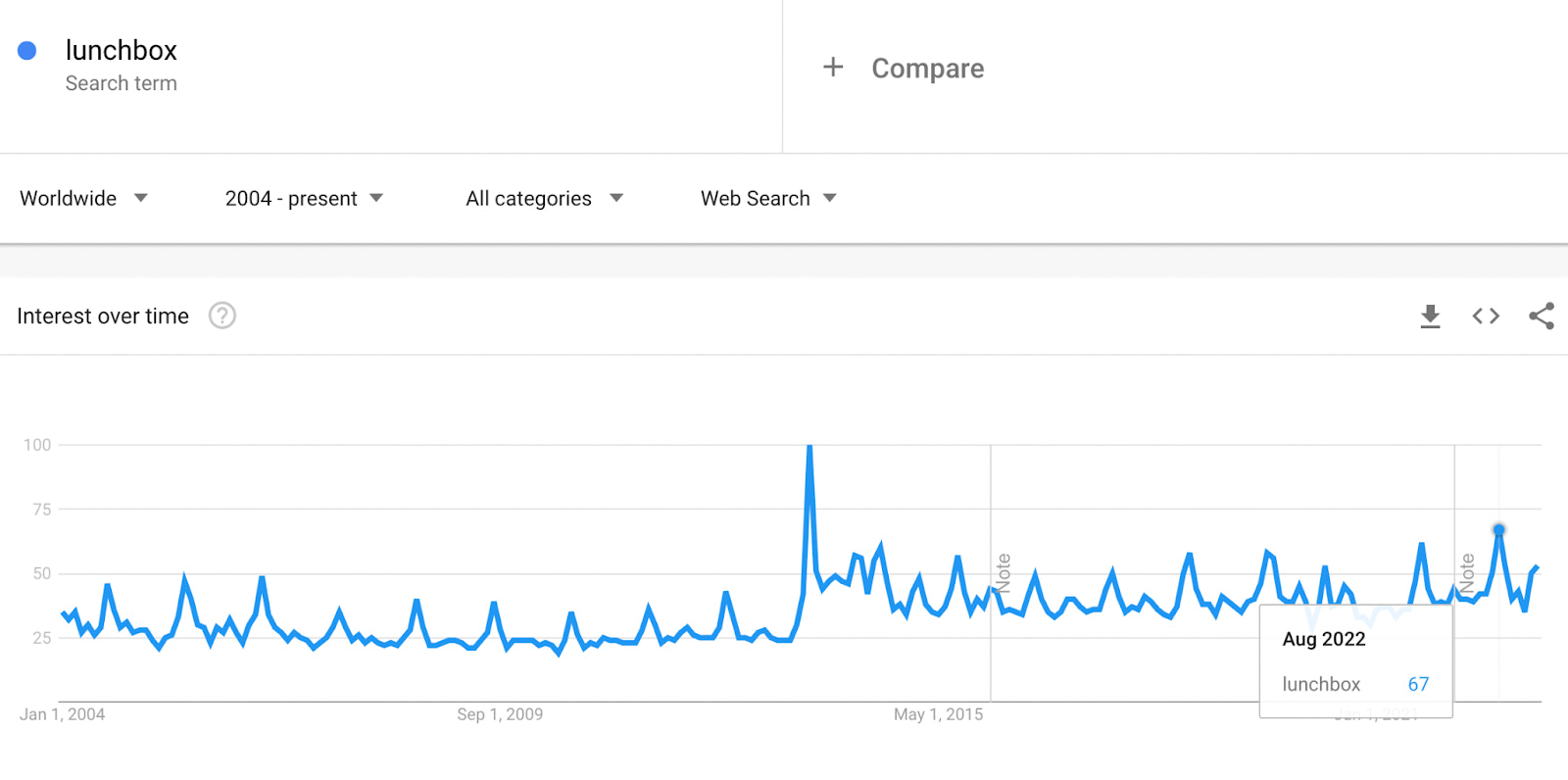
Run a Google Trends report for each product collection and note anyseasonal trends. Build a marketing calendar around peak months to anticipate upcoming demand and stay top of mind when customers are in the market to buy.
4. Validate your ideas by researching different marketplaces
Google Trends gives a good indication on search habits, but not all trending topics are products that people buy. Validate the idea by comparing data from marketplaces before spending thousands of dollars onproduct development.
Marketplaces are amongst the biggest ecommerce platforms;almost half of customersstart their product search on one. If a product is trending on a marketplace and Google Trends, you stand a good chance of making money selling it.
Say you’re selling handmade jewelry. Google Trends data indicates that searches for “gold hoop earrings” are increasing:
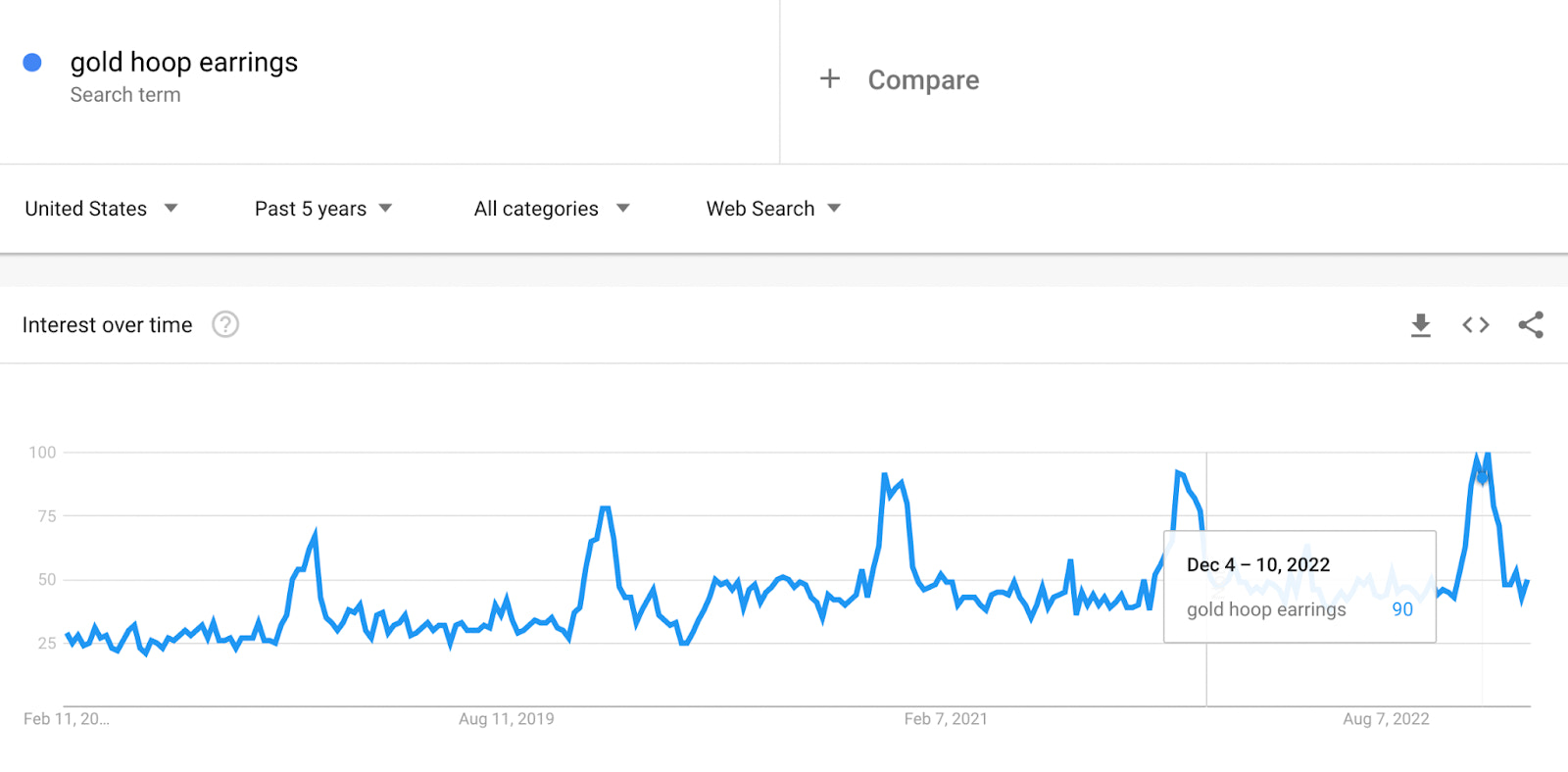
When searching for the same phrase on Etsy, this product appears with a “popular now” tag, indicating that gold hoop earrings are worth considering if you’re a jewelry store looking to sell trending products:

5. Consider your customers’ feedback in making a decision
Customer feedback, combined with Google Trends data, gives you a great starting point forlaunching a business, new product, or service that people actually want.
Design open-ended questions that prompt customers to tell you about what life is like for them right now. What are their problems, challenges, and struggles? What would change in your customer’s ideal world if they could do anything to improve or solve their problems?
Dennis Sanders, founder and CEO ofBurning Daily, used this process to market CBD products. He says, “Instead of promoting our goods to the CBD/THC market who were using them for leisure and entertainment purposes, we shifted our attention to labels that appealed exclusively to individuals with anxiety and comparable disorders.
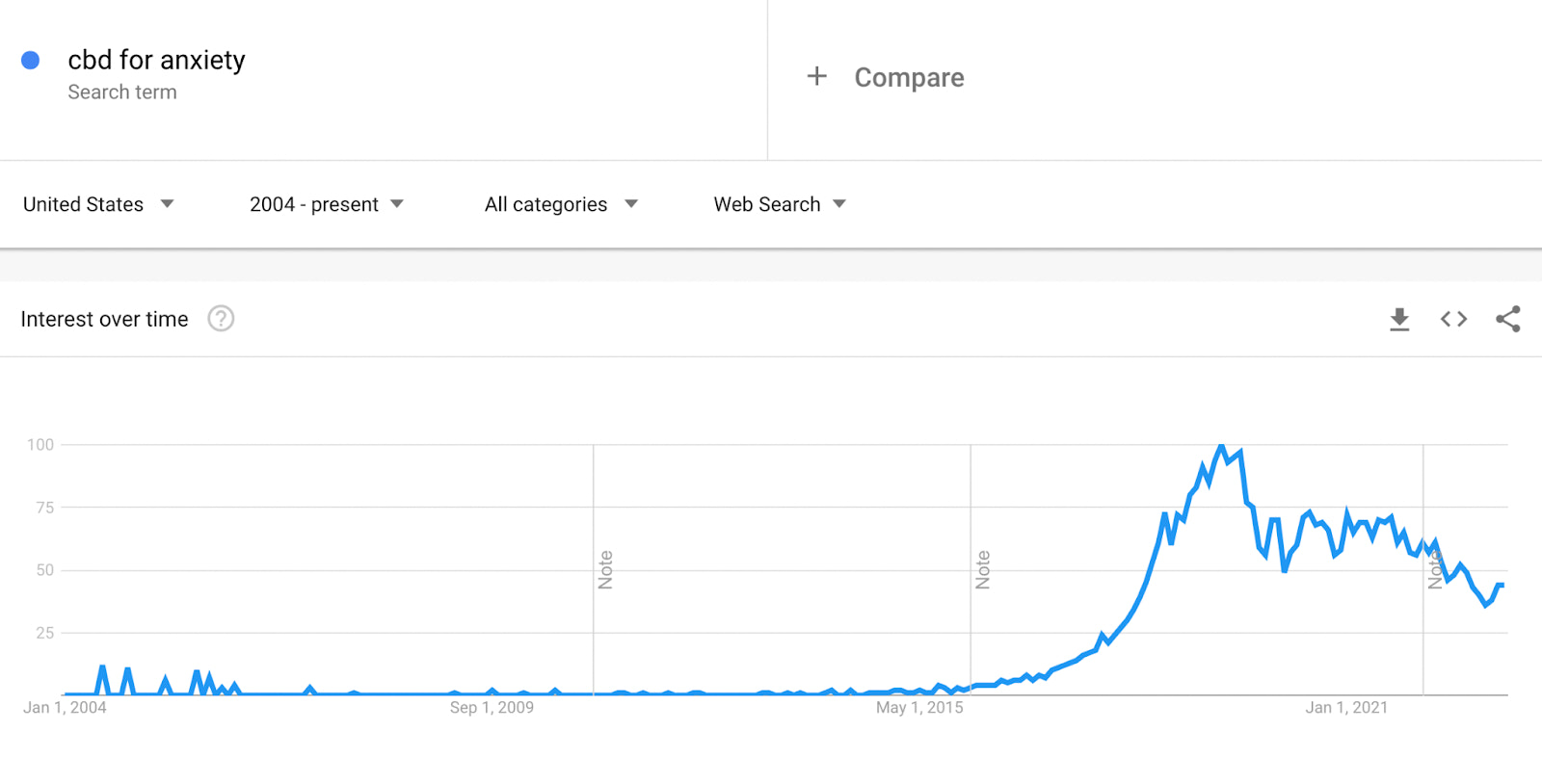
“By keeping an eye on Google Trends, we saw that there was a market for goods that may aid people with anxiety and related disorders,” Dennis says. “Even though our shop has only been open for a short time, this minor change has brought in a flood of new consumers.”
What to look for on Google Trends
You’ve identified seasonal trends and product ideas, and validated your research. But what should you look for when evaluating Google Trends data? Here are five of the most important signals.
Specific phrases
Google Trends can help you get your messaging just right, whether you use outbound orinbound marketingtechniques. Compare different phrases and keywords with the tool, making it easier to narrow down to the specifics you want to use in marketing materials.
For example, you might be in the financial advice industry. There are no regulations around terms like “financial planner,” “financial advisor,” or “financial adviser.” There aren’t any rules to say who can use what title. How do you know what title resonates best with consumers you want to reach?
把短语在谷歌趋势e what people actually look for over time. Start with one of the phrases that you want to consider using, like “financial advisor”:

This graph doesn’t mean much without any context. Hit that Compare button and then you can start making sense of what direction to take with your copy:

“Financial advisor” is the most searched term of these three options. Now you have information with which to make a smart decision about what people actually look for when they need someone in financial services.
Searches by location
Use Google Trends data to explorefuture physical locations. If you’re a coffee brand, for example, you can see specific locations where the search for the term is most popular:
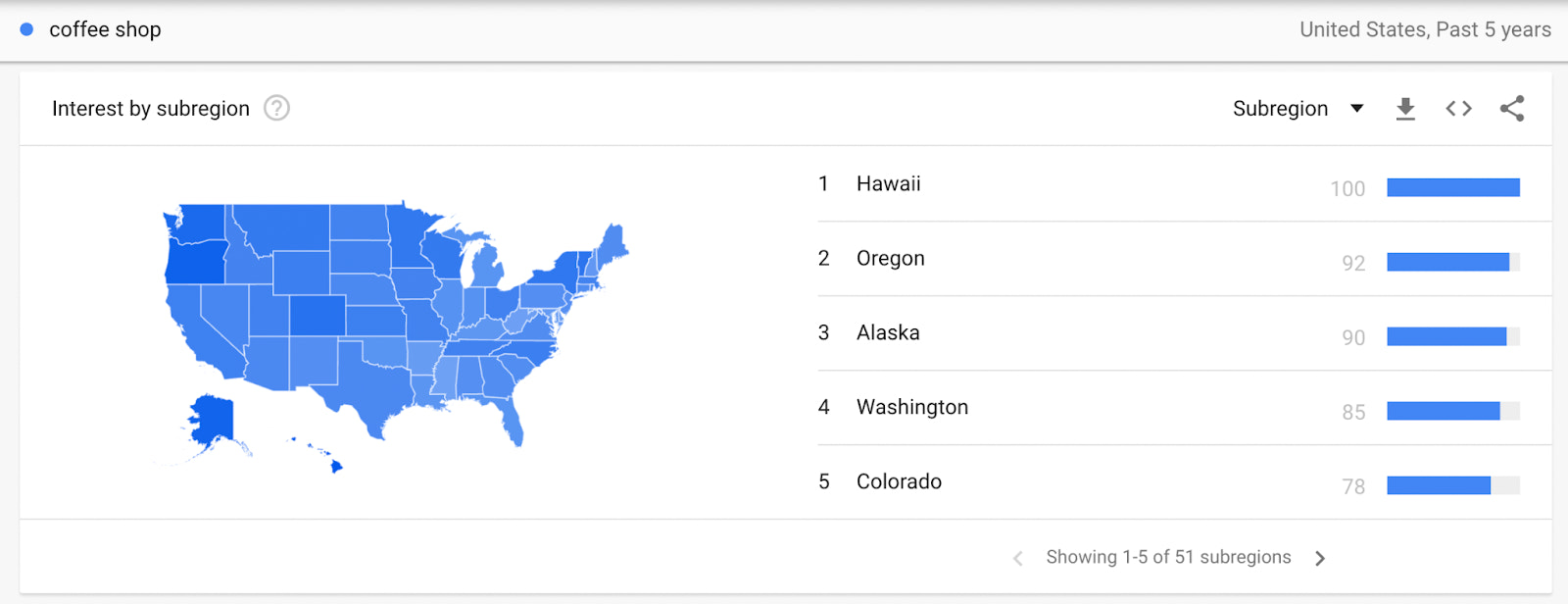
Based on this information, a coffee brand considering where to open a new store should look seriously at Hawaii, Oregon, and Alaska.
Take it from Lou Haverty ofTank Retailer, who used Google Trends. “I wanted to determine if there was enough product demand in certain parts of the country to support factory pickups of certain types of storage tanks I sell,” he says.
“储油罐重产品,根据on where the end user is located, shipping can often cost more than the product itself. The manufacturer I work with has a factory in West Memphis, Arkansas. If I can find customers close by to that factory, I can schedule an appointment for them to pick up the product directly at the factory and avoid shipping costs all together. The ability to do a direct pickup has been a great way to close sales, despite the high shipping costs.”
Shopping-specific searches
People can filter search results by Google Shopping—a subset of Google’s main search engine that only displays product listings from ecommerce sites.
Say you sell hiking equipment. Run a search in Google Trends for the general term “hiking” and filter your results by looking specifically for people who searched in Google Shopping. It’ll narrow down searchers who would likely be interested in purchasing products because they have a specific intention around the term:
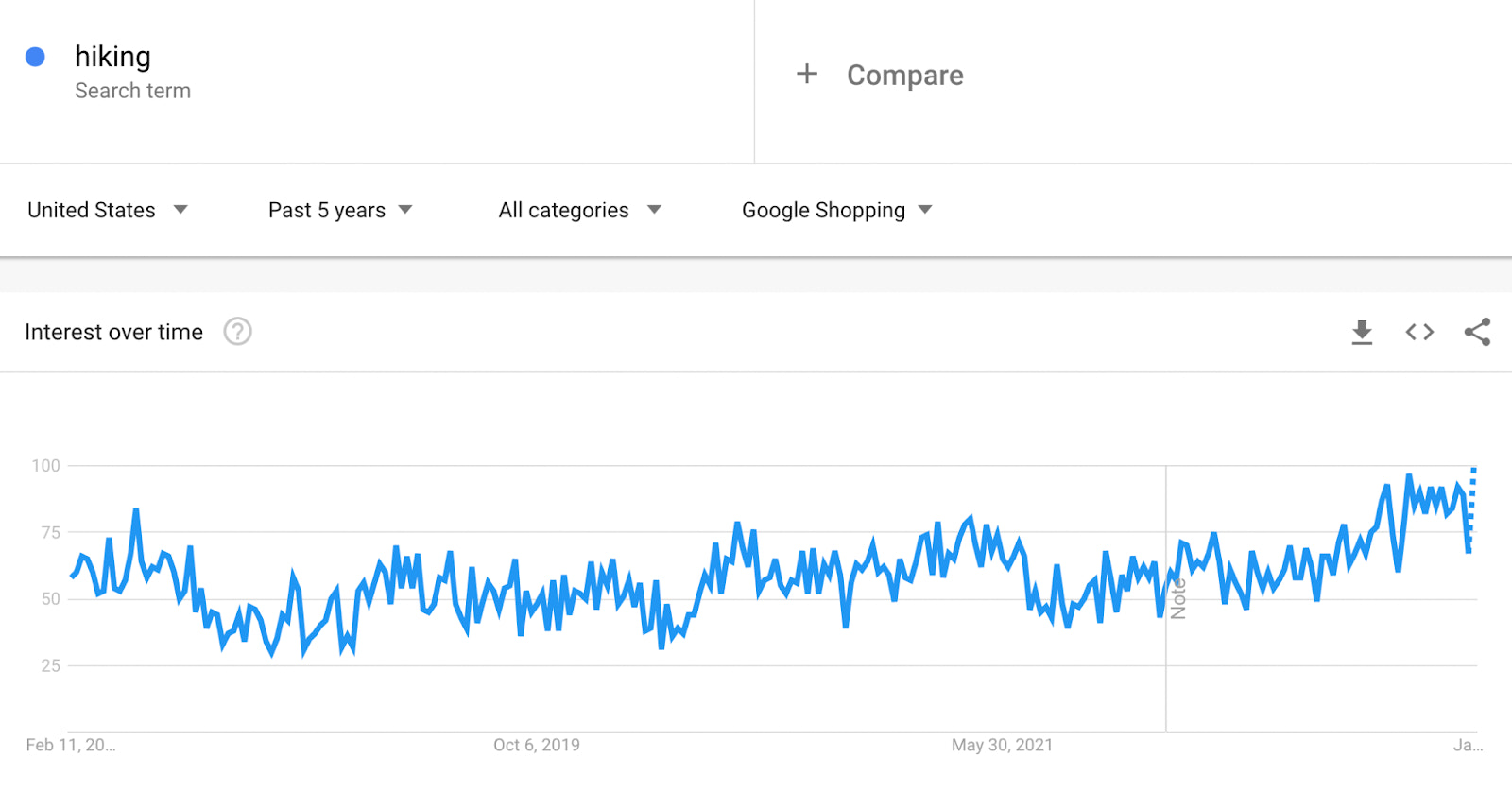
Drill down to your exact location to understand what yourlocal marketsearches for when they’re interested in making a purchase. You’re able to customize inventory based on what people in your area need.
People in Massachusetts who want to search “hiking” via Google Shopping, for example, are looking for related terms like “hiking boots,” “trail equipment,” or “Keen shoes":

But looking at related topics and queries from people in California indicates they have a slightly different intent when they shop for hiking equipment. They search for baby slings, children’s hiking shoes, and waterproof hiking boots:
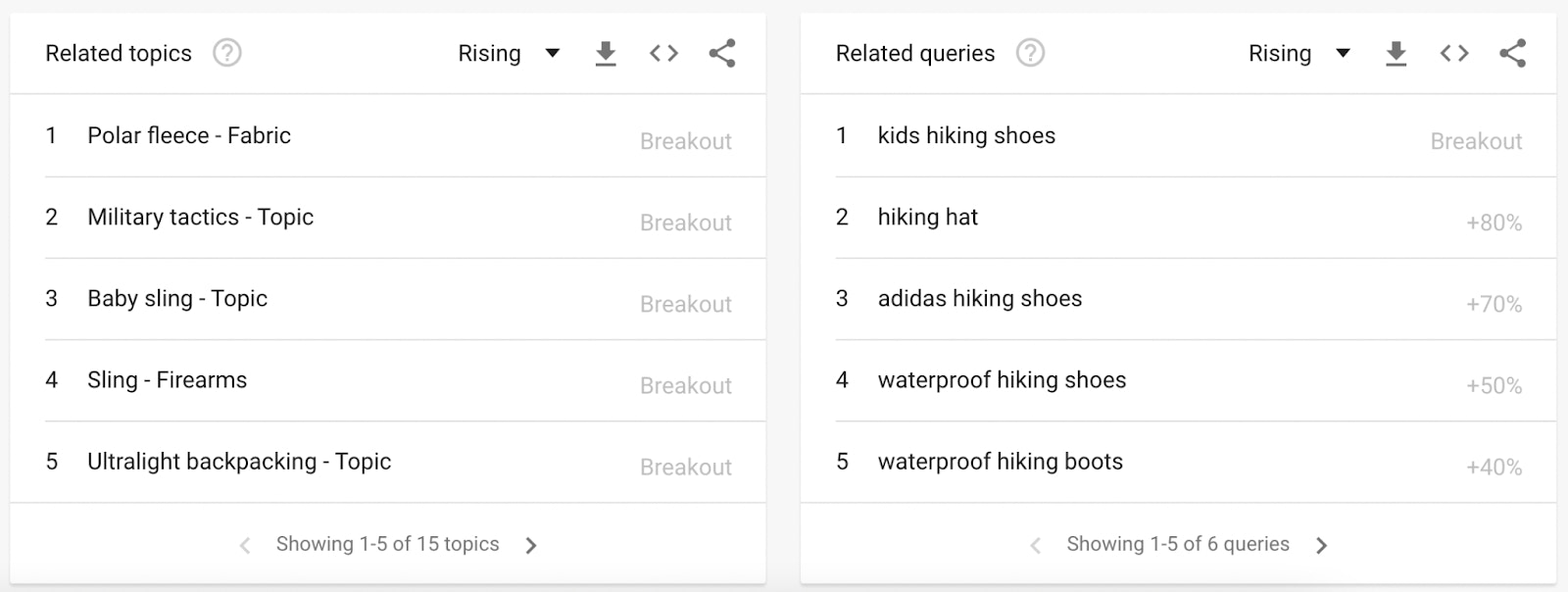
Compare topics to discover what’s popular
Google Trends’ “compare” feature allows you to benchmark several search terms against each other. It’s a useful tool if you’re planning products to sell in various locations, or to different audiences.
Say you want to create amarketing strategy for your retail businessthat sells pet supplies. You want to attract more cat owners to your website, so you start a blog and create content they want to consume.
But what should you write about? Would potential customers be more interested in learning about cat care in general or something more specific, like cat toys?
Google Trends allows you to know (instead of guess) since you can compare terms:

It’s close, but “cat toys” is consistently the more popular search term. You can use this to inform your content strategy andoptimize your site—and your store’s products—for specific toys.
Explore “rising” and “breakout” terms
Google Trends only shows the historical data of a keyword. The trajectory of a keyword gives an understanding of its future, but “rising” and “breakout” terms help do that on a more granular, short-term basis.
Organize the related queries or related topics report using the “rising” option. This tool will show phrases that have a recent upward trajectory, helping you to identify trends before they become even bigger.
Pay close attention to phrases with the “breakout” tag. It indicates that search volume for the keyword has increased by more than 5,000%. This screenshot shows that“white sneakers,” “black sneakers,” and “women’s Nike shoes” are all breakout terms for the phrase “women’s sneakers":
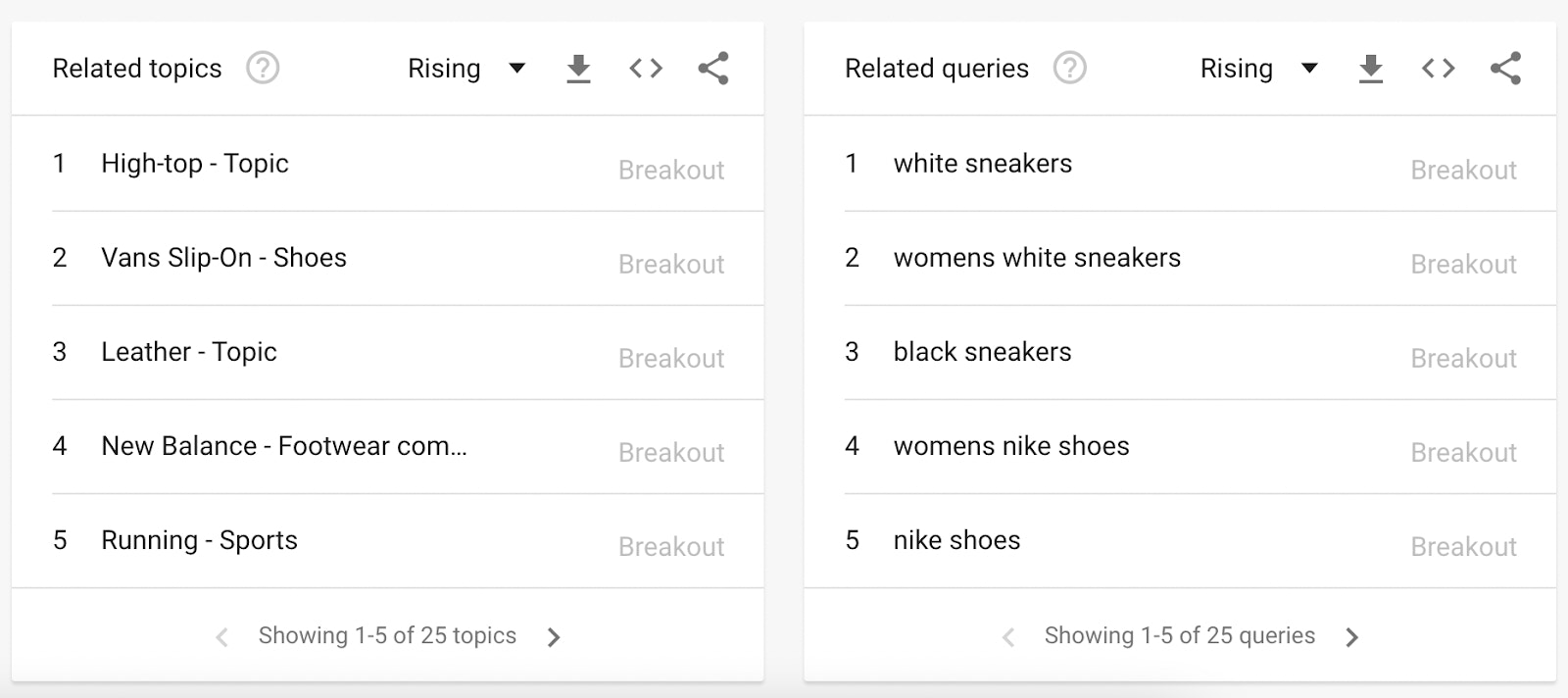
Find great products to sell on Google Trends
Google Trends is a valuable tool to help you find trending products for your retail store.
Use the data as a starting point for your research.Validate your ideaswith customer feedback and marketplace comparisons. It’s the best way to make sure the products on your shortlist actually sell.
Spot sales trends with Shopify POS
Shopify POScollates data from every sales channel and displays it in easily digestible reports. Find your bestselling products by location, identify seasonal trends, and monitor team performance—all from a single dashboard.
Google Trends products FAQ
How do I find trending products on Google Trends?
Open the Google Trends homepage and you’ll see a list of the most popular search terms from the past week. Alternatively, search for a product category and filter the results by Google Shopping. Use the “related queries” section to find product-specific data.
What are the most searched products on Google?
- Hydroponic gardens - Custom gaming keyboards - Water activated eyeliner palette - Over-ear headphones - Messenger bags - Electric pour-over kettle - Weighted blanket*
What is the Google Trends tool?
Google Trends is an analytics platform that collates data from Google search results. Type in a phrase, such as “skincare products,” and see how the pattern of people searching for that term changes over a given period of time.
What is the most popular thing on Google Trends?
- Electric candle warmer - Unique thrift store - Best affordable shapewear - Affordable sustainable clothing - Cozy sweaters for fall** *Data sourced from Google’s Holiday search report. **Data sourced from Google’s 2022 Shopping Trends report.

